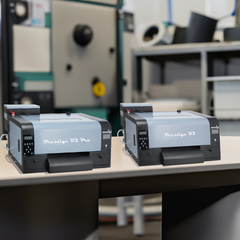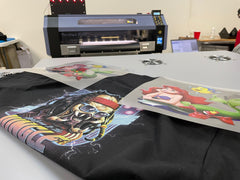Some times it all sounds like gibberish, so we have put together a beginner's guide to basic graphic terms.
Screen Printer's Terms and What They Mean
Enjoy! Read more and begin to bridge the graphic language barrier with these graphic terms with everyday jobs.
Bleed
Bleed is a printing term that is used to describe a document which has images or elements that touch the edge of the page, extending beyond the trim edge and leaving no white margin. When a document has bleed, it must be printed on a larger sheet of paper and then trimmed down.
Vector Image
Vector graphics use geometrical primitives such as points, lines, curves, and shapes ot polygons. All of which are based on mathematical expressions. These represent images in computer graphics. Vector graphics are preferred as they can be magnified infinitely without loss of quality, while pixel-based graphics lose detail as they are enlarged.
Common vector file types: .EPS .AI .SVG .PDF
Raster Image
Unlike a vectored image, raster images are resolution dependent. When you change the size of a raster image, you shrink or stretch the pixels themselves. This can result in a significant loss of clarity and very blurry image. Determining the most appropriate image resolution for a given printer-resolution can pose difficulties, since printed output may have a greater level of detail than a viewer can discern on a monitor. Typically, a resolution of 150 to 300 PPI works well for a 4-color process (CYMK) printing.
Common raster file types: .JPG .GIF .PNG .TIF .BMP
Camera Ready
The term "camera-ready" was first pioneered in the plate-making process, where the final layout of a document was attached to a "mechanical" or "paste up". Then, a stat camera was used to photograph the mechanical, and the final offset printing plates, or screen printing films were created from the camera's negative. In this system, a final paste-up that needed no further changes or additions was ready to be photographed by the process camera and subsequently printed. If your art is ready to print- it is camera ready
CYMK
The CYMK color model (process color, four color) is a subtract color model, used in color printing, and is also used to describe the printing process itself. CYMK refers to the four inks used in some color printing: Cyan, Magenta, Yellow, and Key (Black).
RGB
The RGB color model (Red, Green, and Blue) refers to a system for representing the colors to be used on a computer display. Red, green, and blue can be combined in various proportions to obtain any color in the visible spectrum. Levels of R,G, and B can each range from 0 to 100 percent of full intensity.
DPI and PPI
DPI stands for Dots per Inch which technically means printer dots per inch. PPI stands for Pixels per Inch
Print Resolution
In printing, DPI (dots per inch) refers to the output resolution of a printer or image setter, and PPI (pixels per inch) refers to the input resolution of a photograph or image. DPI refers to the physical dot density of an image when it is reproduced as a real physical entity, for example printed onto paper.
Screen Resolution
Screen resolutions defers to the clarity of the text and images displayed on your screen. At higher resolutions, such as 1600 x 1200 pixels, items appear sharper. They also appear smaller so more items can fit on the screen.




